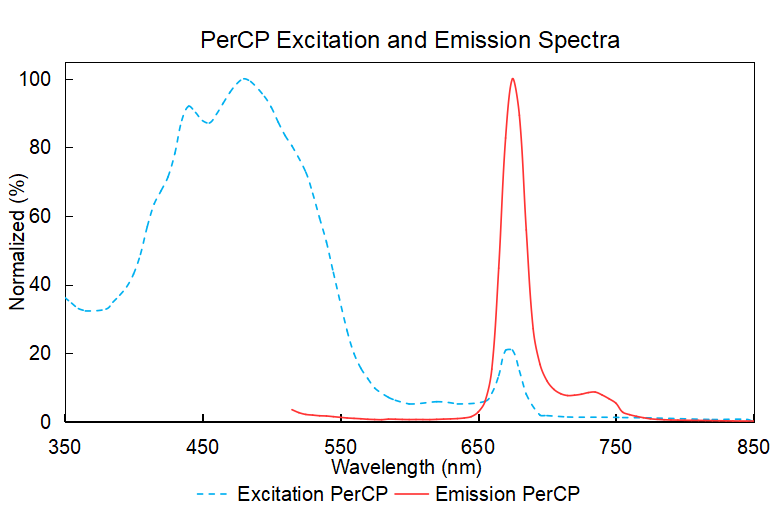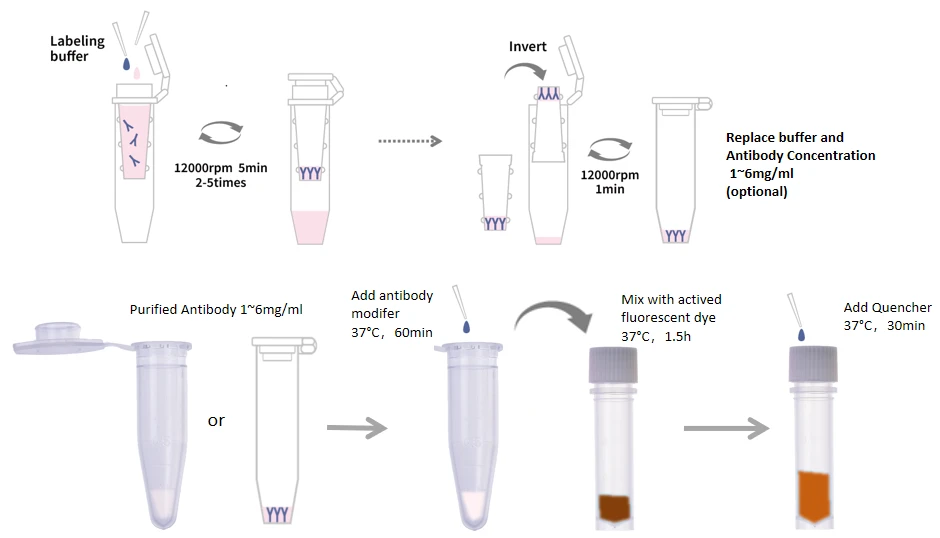EnkiLife PerCP labeling kit contains multiple components for labeling antibody proteins, such as the activated lyophilized PerCP fluorescent dye, labeling buffer, and other chemical reagents, enabling easy and reliable antibody labeling for use as fluorescent probes.
Features
Activated dye with extended arm: A specially designed long flexible arm minimizes spatial hindrance between antibodies and the fluorescent dye. This protects antibody activity and enhances labeling efficiency.
Site-specific conjugation: Optimized site-specific conjugation technology ensures uniform antibody labeling and improves efficiency.
Rapid process: The simple procedure allows for efficient labeling completion in as fast as 3 - 4 hours.
Dye stability: The chosen high-performance fluorescent dye is stable, resistant to degradation, and suitable for various subsequent applications, such as fixed sample detection.
User-friendly operation: Each dye reagent is pre-optimized for corresponding antibody amounts. No complex calculations or ultrafiltration steps are required if the antibody sample meets the labeling conditions. The solid dye form ensures batch stability. Simply mix the reagents according to the steps to achieve good results.
Flexibility: In the large-scale kit, the dye is pre-portioned for consistent batch performance, facilitating multiple labeling uses.
Comprehensive reagents: The kit includes a labeling preservation solution, covering the entire process from labeling to preservation. No additional reagents are needed, making the process worry-free and convenient.
Dye Introduction
PerCP is a complex molecular dye composed of peridinin, chlorophyll, and lipids bound to peridinin-chlorophyll a protein. The peridinin molecule absorbs light in the blue-green wavelength range (470 nm to 550 nm) with a maximum emission at 675 nm. PerCP has a large Stokes shift and is well excited at 488 nm, with its maximum emission peak at 675 nm. Its emission spectrum is relatively narrow, which can greatly reduce the impact of fluorescence spillover when used in multicolor flow Cytometry. Although PerCP itself has relatively weak fluorescence intensity, its brightness can be enhanced when conjugated with other small molecule dyes such as Cy5.5.
Properties of PerCP
Form: brown solid
Molecular Weight: ~ 38 kDa
Excitation Light Sources: 488 nm
Excitation Wavelengths: 482 nm
Emission Wavelength: 677 nm
Molar Extinction Coefficient (L/(mol・cm)): 406000
Purity: A478/A280 ≥ 4.0
Solubility: Soluble in aqueous solutions
Activating Group: Maleimide (MAL)
Activation Effect: MAL/PerCP = 1.1- 3
PerCP Spectrum

Kit Specifications
Product composition | Content of components in different specifications | |||
40 μg antibody | 200 μg antibody | 1 mg antibody | Storage temperature | |
Activated PerCP | 1 tube | 1 tube | 5 tubes | -20 °C, away from light |
Labeling Buffer L | 2 mL | 2 mL | 2 mL | 4 °C, away from light |
Antibody Modification Reagents | 60 μL | 60 μL | 60 μL | -20 °C, away from light |
Ultrafiltration Tube * ,50K MWCO | 1 set ** | 1 set ** | 1 set ** | RT |
Blocking reagent | 300 μg | 300 μg | 300 μg | -20 °C, away from light |
DMSO (dissolve blocking reagent) | 50 μL | 50 μL | 50 μL | -20 °C, away from light |
Labeled protein storage solution | 200 μL | 1 mL | 5 mL | 2-8 °C |
Recommended amount of labeled antibody | Each tube is labeled with 20-40 μg, and the best is 20 μg | Each tube is labeled with 50-200 μg, and the best is 100 μg | Each tube is labeled with 50-200 μg, and the best is 100 μg | |
Labeling Principle
Conventional Antibody Labeling Process
STEP 1:Ultrafiltration buffer exchange and concentration (optional)
STEP 2:Antibody activation
STEP 3:Labeling reaction
STEP 4:Quench/Blocking and preservation

Other Issues:
Refer to the FAQ section




